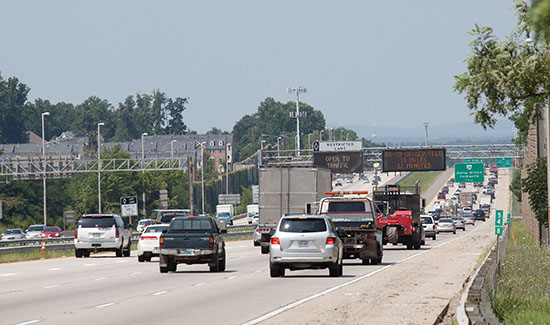
One of the most congested routes in Northern Virginia is the section of Interstate 66 from U.S. 15 to the District, the main east-west corridor in the region.
VDOT is in the early stages of deciding what to do. Contracting and coordinating development of the segment of I-66 from U.S. 15 to I-495 is the subject of a second study, with plans to finalize design and construction once that study is completed and public concerns are addressed. The project is expected to cost between $2 and $3 billion.
The first study for I-66 outside of the Beltway examined multimodal options for the corridor, including Virginia Regional Transit extensions and Metrorail extensions, plus adding general purpose lanes and a toll lane.
“In that study, there was no single alternative that would meet all of the needs of the corridor,” says Susan Shaw, megaprojects director and design-build program manager for VDOT. “We needed something that provided travel options for people that would provide choices so they could carpool, ride a bus or get on a train. That is the goal of the project.”
VDOT is now looking at adding one lane in each direction and providing a barrier for that lane similar to the I-495 express lane. “That would be a tolled facility,” Shaw says.
She adds that they are studying leaving the median space open by 42 feet, which would make it wide enough for Metrorail or some other type of transit. The decision for extending the Orange line out I-66 is still up in the air. “We are not studying extending Metro,” she says. “But we are studying not precluding extending it so that it could be done in the future.”
For now, VDOT is collecting resident input from various public meetings as part of the next step in the second study, and there are plans to begin construction by 2017 with a completion deadline around 2020. “We won’t be able to build ourselves out of congestion,” Shaw says. “But this proposal will sort of set the stage for this corridor.
“Interstate 95 has this whole culture around carpooling. They go to park and ride lots and form their own carpools,” she says. “We don’t have that so much in the 66 corridor. Think of how many people a lane of pavement can move if we have people wanting to do that. We are really looking to change the culture in the corridor.”
Development along the other segment of I-66 inside the Beltway, from the District out to I-495, is covered in a separate mobility study. “We are going to advance the multimodal study for that part of 66 that was completed a few years ago,” says Renee Hamilton, deputy district administrator for VDOT. “As part of that study, we are going to be looking at transit improvements and enhancements in the corridor, as well as a toll lane being a potential option.”
(May 2015)
